U.S. Geological Survey Circular 1294
All countries are responsible for safeguarding the environment and for maintaining a relatively intact world for future generations. This is true not only for the mining and mineral exporting countries but also for the industrialized ones that buy and import most of their raw materials, especially the high-value metals and energy supplies. Together, all countries are responsible for working out a global strategy for exploiting mineral resources that fulfills the requirements of sustainable development.
Highly industrialized countries such as those of Western Europe, which import all of their metallic mineral resources and most of their energy supplies, still produce a large proportion of their required nonmetallic mineral resources (that is, raw materials for construction and many of the industrial minerals). In Germany, for example, nonmetallic mineral resources total about 80 percent of mineral commodities consumed. The lifetime curve of nonmetallic resource production in a country shows a positive time offset relative to the curve for production of metallic resources and attains a maximum when almost all of the metal mines in that country have been abandoned (fig. 1). It follows that the industrial countries, which are the major importers of mineral resources and thus are customers of the rest of the world, must have a vested interest in the sustainable development of mineral resources, not only from a global point of view but also in a local context (Wellmer and Becker-Platen, 2001).
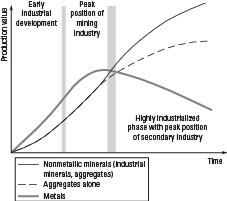
Figure 1. Comparison of the production trends of metallic ores, industrial minerals, and aggregates in industrialized countries (Wellmer and Lorenz, 1999; modified from Bristow, 1987).
Sustainable development is a normative term like liberty or equality according to German philosopher Immanuel Kant. In the United Nations (U.N.) Report, “Our Common Future,” commonly called the “Brundtland Report,” sustainable development is defined as development that meets the needs of the present without compromising the ability of future generations to meet their own needs (Brundtland, 1987, p. 8). This has become the most accepted definition internationally. It has been expanded by the U.N. Environment Programme, which added that the concept also requires the maintenance, rational use, and enhancement of the natural resources base that underpins ecological resilience and economic growth and that it implies progress toward international equity (United Nations Environment Programme, 1989).
The next steps were the Rio Declaration at the U.N. Conference on Environment and Development in Rio de Janeiro in 1992 and Agenda 21, which stress three objectives of sustainable development—(1) to conserve the basic needs of life, (2) to enable all people to achieve economic prosperity, and (3) to strive toward social justice. All three objectives initially should be considered to have the same priority. Whereas the Brundtland definition deals with “intergeneration fairness,” Agenda 21 adds the element of “intrageneration fairness.”
The first practical guidelines for sustainable development came from the German forestry administration. The man credited with inventing sustainable development is von Carlowitz, who published the book “Sylvicultura oeconomica” (von Carlowitz, 1713). He was the head of the mining administration of the famous silver mining district around Freiberg, Saxony. In this position, he was responsible not only for the mining and smelting operations in his district but also for the forestry because wood was needed for timbers in the underground mines and vast amounts of wood were needed to produce the charcoal required to smelt the silver ores. He realized that the uncontrolled cutting of the forest for these purposes would lead to the collapse of forestry production. He was the first to spell out what sustainable development meant in forestry (that is, that the amount of wood cut should not exceed the growth rate).
Although his rule for renewable resources is quite logical, at the beginning of the 18th century, it was difficult for it to become broadly accepted. Even today, there is international resistance to similar sustainable development initiatives; for example, the use of quotas on fish catches to avoid overfishing. The reason for such resistance was and always is that, when sustainable development is introduced for a natural resource, structural changes must occur in the economy and in society. People and interest groups directly affected frequently resist these changes.
In contrast to guidelines for the use of renewable resources, guidelines for nonrenewable resources are more difficult to develop. In 1993, the Enquete Commission on Protection of Man and the Environment, set up by the German Federal Parliament, formulated four general rules for the sustainable development of natural resources (Enquete-Kommission Schutz des Menschen und der Umwelt, 1993); these rules can be applied worldwide. Rules 1 and 2 concern resources, and rules 3 and 4 concern the resilience of the environment.
Rule 1. Use of renewable resources.—The rate of consumption of renewable resources should not exceed the rate at which they can be regenerated. This rule is the same in essence as that already formulated by von Carlowitz (1713).
Rule 2. Use of nonrenewable resources.—The consumption of nonrenewable resources should not exceed the amount that can be substituted by functionally equivalent renewable resources or by attaining a higher efficiency in the use of renewable or nonrenewable resources.
Rule 3. Material and energy input.—Material and energy input into the environment should not exceed the capacity of the environment to absorb them with minimal detrimental effects.
Rule 4. Rate of anthropogenic input and environmental interference.—The rate of anthropogenic input and environmental interference should be measured against the time required for natural processes to react to and cope with the environmental damage.
If one critically examines the various elements of the concept of sustainable development as described above, together with these four rules for the sustainable development of natural resources, there is an apparent contradiction.
The creation of wealth to achieve economic prosperity, as outlined above, is one of the three cornerstones of sustainable development in the Rio Declaration of 1992. However, there is no creation of wealth without the direct or indirect use of nonrenewable resources. Even today, mineral resources are needed in our highly industrialized society, wherein creation of wealth is based to an ever-increasing degree on information technology. For example, 31 metals are needed to construct a personal computer (PC) (Jeffery, 1998). A PC requires electricity to function. Electricity is generated and delivered as a part of the vast infrastructure required to build and maintain modern societies. An infrastructure in turn requires construction materials such as steel and bricks, energy for heating and transport, and food produced in abundance by using mineral fertilizers.
Later, we will examine in detail how rule 2 can be fulfilled for nonrenewable resources. We interpret rule 2 as follows: “The consumption of nonrenewable resources should not exceed the amount that can be substituted by functionally equivalent resources or replaced in other ways” (Wellmer and Becker-Platen, 2002).
Let us consider why we need natural resources. With a few notable exceptions, exemplified here by potassium and phosphate used as fertilizers in agriculture, it is not the metal or raw material as such that is important, but a function that can be fulfilled by the material properties of the commodity (for example, the electrical conductivity of copper). Other commodities, sometimes using a totally different technology, also can perform these functions. For example, copper telephone wires are used for transmitting information. These have been extensively replaced by fiberglass cable made of silica, whose availability on Earth is limitless. Another solution to the problem of transmitting information is wireless transmission using directional radio antennae or satellites. Each solution requires different materials.
Metallic and nonmetallic resources normally are considered to be nonrenewable. However, in a few exceptional cases, they can be viewed as renewable. An example is diatomite. One of the uses of diatomite is as a filter medium for beverages, and one of the places this mineral is exploited is in Lake Myvatn, Iceland. Diatoms in the lake metabolize siliceous exhalations percolating through the lake and regenerate the deposit as they die and settle to the lake bottom. Another example is gravel in rivers that are eroding mountains. If gravel can be extracted from a riverbed without increasing the erosive power of the river, and thus damaging embankments or bridges, its extraction meets the sustainable development guideline of rule 1 for renewable resources. In this way, about 5 million metric tons of gravel are produced annually from rivers flowing from the Alps into Germany. Nevertheless, demand for gravel in southern Germany is substantially higher.
Substances dissolved in seawater also can be considered renewable resources. The prices of sodium, potassium, bromine, and magnesium salts, for example, will determine when technologies will be developed for commercial extraction of these salts from the ocean. Already, about 16 percent of sodium chloride is produced directly from seawater (Wellmer and Becker-Platen, 2001).
Most of the mineral resources we consume, of course, are nonrenewable. Nonetheless, ways must be found to fulfill the Brundtland Report requirement that future generations be able “to meet their own needs.” Current annual world consumption of mineral and energy resources is about 32×109 metric tons (32 billion metric tons), worth about 952 billion euros. Figure 2 is a bar diagram showing the annual world production of all mineral and energy resources by quantity in 1998. Figure 3 is the equivalent diagram based on value. In both diagrams, the base of the pyramid is formed by sand and gravel, aggregates, and energy resources, all of which are required to meet our basic needs for housing, heating, and transportation. Most of the nonmetallic resources are in the lower half of the quantity pyramid, whereas most of the metals are in the upper part of the quantity pyramid. Only the following nine metals are produced at a rate of more than 1 million metric tons annually: iron (Fe), by far the largest, aluminum (Al), copper (Cu), manganese (Mn), zinc (Zn), chromium (Cr), lead (Pb), titanium (Ti), and nickel (Ni).
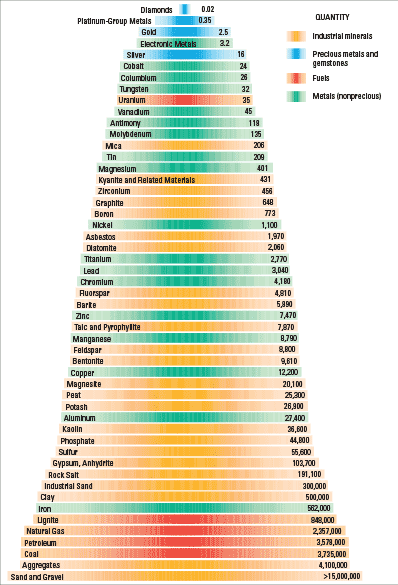
Figure 2. World primary production of mineral and energy resources in 1998 by quantity (Kippenberger, 2001). Ores are given as metal equivalent in thousands of metric tons; natural gas, in millions of cubic meters. The label “Diamonds” represents all precious and semiprecious gemstones. Electronic metals include gallium, indium, and germanium. Details about the top of the pyramid are in figure 4.
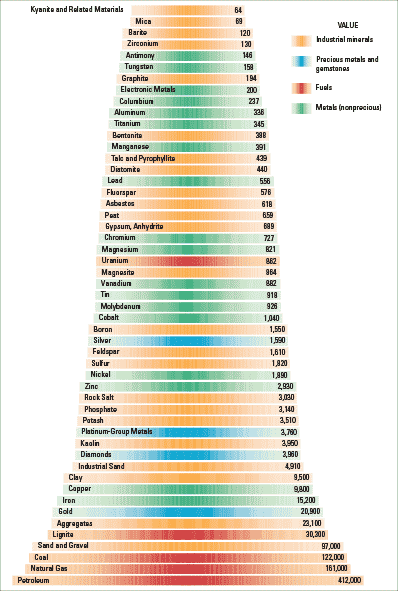
Figure 3. World primary production of mineral and energy resources in 1998 by value (Kippenberger, 2001). Values are given in millions of euros. Commodities are the same as in figure 2.
The very top of the quantity pyramid, of course, is made up of the precious metals and semiprecious and precious stones that together are represented by the most important precious stone, diamond. The special and “electronic” metals, like gallium, indium, or germanium, also are at the top of the quantity pyramid (fig. 4). These metals are the most important commodities in our information technology society. They are essential for electronic components in measuring and control-engineering technology, which are key technologies for increasing the efficiency with which we utilize our resources, especially our energy resources. These metals are used annually in tens or hundreds of metric tons and are critical components for the efficient utilization of resources that are used and consumed on the order of millions and billions of metric tons.
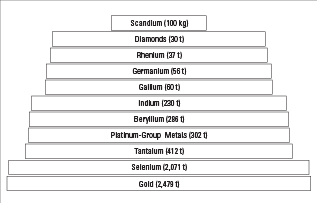
Figure 4. A modified expansion of the top of the quantity pyramid from figure 2, showing the precious metals, precious and semiprecious stones (designated by Diamonds), and electronic metals (including gallium, indium, and germanium) (Kippenberger, 2001). Quantities are in metric tons (t) and kilograms (kg).
One can ask whether we can maintain this level of consumption and still fulfill the requirements of sustainable development, particularly in view of the fact that we have consumed more resources since World War II than during the whole of our long history before that. Figure 5 shows the relative cumulative consumption trends of the “old” metals—gold (Au), tin (Sn), copper (Cu), and iron (Fe)—using total consumption as of today as 100 percent. Of these four metals, iron is the “youngest.” The beginning of its use in the Middle East marks the birth of the Iron Age about 3,400 years ago; gold, tin, and copper have been used even longer. Figure 5 clearly shows that in 1945, at the end of World War II, cumulative consumption of these metals was less than 50 percent of the cumulative consumption of 1995, only 50 years later.

Figure 5. Cumulative world production of iron (Fe) ore, gold (Au), copper (Cu), and tin (Sn) (Wellmer and Becker-Platen, 2001; courtesy of Encyclopedia of Life Support Systems Publishers, Oxford, United Kingdom).
Few people realize how much the production and consumption of natural resources have accelerated. The following two examples are given to illustrate this trend.
The most intensively researched historical statistics probably are those for gold production (table 1). During the nearly 1,000 years from the end of the Roman Empire at about A.D. 500 to the discovery of the Americas by Columbus in 1492, the estimated total world gold production was about 2,500 metric tons, approximately the same as a single year’s production today.
| Table 1. World gold production. [From Wellmer and Becker-Platen, 2001; courtesy of Encyclopedia of Life Support Systems Publishers, Oxford, United Kingdom] |
|
| Period | Production, in metric tons |
|---|---|
| 3900 B.C.–A.D. 500 (end of Roman Empire), 4,400 years | 10,257 |
| 500–1492 (discovery of America), 992 years | 2,472 |
| 1493–1999, 507 years | 125,059 |
| Total: 5,899 years | 137,778 |
| 1999, 1 year | 2,514 |
It is tempting to correlate the increase in mineral resource production and consumption with the increase in world population, which grew from about 1.6 billion people in 1900 to the following milestones: about 2.4 billion in 1950, about 3.2 billion in 1965, and more than 6 billion (6×109) in October 1999. However, the bulk of mineral resource consumption takes place in industrialized countries, which have had only a very moderate population increase. The large increase in population has occurred mainly in the developing nations (fig. 6). This uneven consumption pattern, however, offers an opportunity to find a solution to the problem of sustaining the future supply of mineral resources.
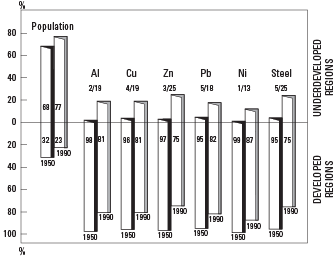
Figure 6. Distribution in percent of world population and metal consumption between the underdeveloped and developed regions in 1950 and 1990. Data for developed regions from Wellmer and Becker-Platen, 2001; courtesy of Encyclopedia of Life Support Systems Publishers, Oxford, United Kingdom. Al, aluminum; Cu, copper; Zn, zinc; Pb, lead; Ni, nickel.
The efficiency of production and utilization of mineral raw materials will have to be increased. This improvement requires investments in research and development, which can be much more easily undertaken in the relatively rich industrialized nations than in the relatively poor developing nations. Moreover, industrialized nations start much higher on the learning curve for efficient use of natural resources than do the developing nations. After development by industrial nations, more efficient technologies then can be adopted by the developing nations to meet the natural resources needs of their growing populations. Such development and application of technology allow us to extend the three-cornerstone concept in the Rio Declaration of 1992 to a four-cornerstone concept by adding the need for research and technology to achieve a higher efficiency in the use of natural resources (fig. 7). In the long run, including research and technology is the only possibility for achieving sustainable development globally.
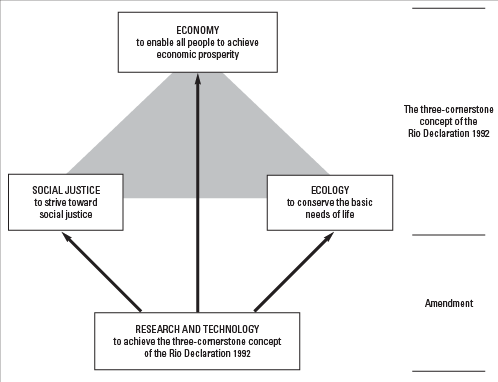
Figure 7. The three-cornerstone concept of the 1992 Rio Declaration (economy, ecology, and social justice) extended to a four-cornerstone concept that includes research and technology to achieve sustainable development globally.
The future availability of resources commonly is estimated by using the concept of “reserves lifetime,” which is defined as the known reserves divided by current annual consumption. In practice, however, reserves lifetime is a completely inappropriate measure of future availability. This estimate is influenced by many factors, such as type of deposit, distribution of reserves according to deposit size, costs, price level, intensity of exploration, and development of technology. The reserves lifetime is nothing more than a statistical snapshot of a dynamic system that says much more about the need for innovation than about true future availability. Commodities that occur in extensive seams, such as potash or coal, and that cover considerable areas in some deposits typically have lifetimes of more than 150 years because it is much easier to calculate and extrapolate reserves for such commodities than for those occurring in more local discontinuous concentrations. Typical representatives of the commodities having localized concentrations are lead and zinc, which have lifetimes of only 20 to 25 years. The lifetimes for lead and zinc, however, have remained the same since 1950, despite an increase in production from 1.7 million metric tons of lead and 2.2 million metric tons of zinc in 1950 to 3.0 million metric tons of lead and 8.0 million metric tons of zinc in 1999. The stability of these lifetimes means that a dynamic balance between consumption and the discovery of new reserves of these two metals has been maintained for the last 50 years. Obviously, a far larger and more constant effort is needed to keep a dynamic balance for commodities with short lifetimes than for those with very long lifetimes (Wellmer and Becker-Platen, 2001). Thus, reserves lifetime figures can be interpreted as indicators of the need for innovation and of the available time buffer during which functionally equivalent substitutes for scarce resources must be found in accordance with rule 2 of the Enquete Commission.
With this understanding of the reserves lifetime concept, let us take a look at mineral fertilizers. Generally, we need only the functions of natural resources, not the natural resources as such. Among the exceptions to this statement are potassium (potash) and phosphorus (phosphate). Both are essential plant nutrients. Like water, they have no substitutes. In this respect, potassium and phosphorus must be considered among the most critical commodities. Fortunately, their reserves lifetimes are quite high—81 years for phosphorus and 329 years for potassium—giving humanity a substantial time buffer to find sustainable solutions. Moreover, the ultimate source of potassium is seawater, which is practically a renewable resource. Although it is more difficult to develop a comparable concept for sustainability of phosphorus, future options to do so are likely to include improved fertilizing technology, precision farming, and improved recycling of wastes such as manure.
If one wants to understand the future supply of mineral resources, one must consider their supply and demand cycle. This cycle is driven primarily by the price of the commodity, although it should be noted that other aspects, such as increased environmental awareness and concern, are playing an increasingly important role. It also is essential to consider these cycles in connection with one further resource—human creativity. Discovery of new reserves may be viewed as only a temporary possible solution to mineral resource sustainability. Under rule 2 of the Enquete Commission, a number of other potential solutions to sustainability of nonrenewable resources are emphasized and rely on human creativity. Examples for mineral resources include (1)enhancing recovery from the mineral deposit, (2) finding new substitutes, (3) improving recycling, (4) reducing consumption by more efficient utilization, and (5) finding totally new solutions (such as the new technologies that allow transmitting information over fiberglass cables instead of copper wire or by wireless transmission using satellites). Some of these examples are described in more detail below.
Enhancing recovery.—In a worldwide materials-flow study, Kippenberger (2001) examined the recovery rates for mining, beneficiating, and smelting eight mineral and energy commodities: iron, aluminum, copper, nickel, chromium, manganese, phosphate, and coal. His results (summarized in table 2) show that total recoveries of these commodities from mining to smelting are well below 100 percent, indicating that significant improvements in utilization efficiency are possible in the future.
| Table 2. Recovery rates during mining, beneficiation, smelting, and refining of aluminum, chromium, iron, copper, manganese, nickel, phosphate, and hard coal. [Modified from Kippenberger, 2001] |
||||
| Commodity | Percent of world production included in this survey | Total recovery, in percent | Share of underground mines, in percent | |
|---|---|---|---|---|
| Aluminum | Mines Smelters/refineries |
79 96 |
87 | 0 |
| Chromium | Mines Smelters/refineries |
77 ~100 |
65 | 70 |
| Iron | Mines Smelters/refineries |
65 90 |
77 | 4 |
| Copper | Mines (Relative to capacity) Smelters/refineries |
~75 ~94 |
71 | 35 (estimated) |
| Manganese | Mines Smelters/refineries |
51 ~97 |
47 | 30 |
| Nickel | Mines Smelters/refineries |
70 70 |
76 | 53 |
| Phosphate | Mines | 61 | 64 | 3 |
| Hard coal | Mines | 91 | 77 | 75 |
Finding new substitutes.—The effect of rising prices as a driving force on finding new solutions to mineral resource sustainability is well demonstrated by the cobalt supply shortage resulting from the political Shaba crisis in Zaire in 1978. This crisis caused the price of cobalt to skyrocket. Zaire, now the Democratic Republic of Congo, is the world’s largest cobalt producer. In 1976, the German Government commissioned a study to analyze what effect a shortfall of 30 percent of a commodity would have on industry. For chromium and cobalt, which were considered very difficult to replace with substitutes, it was found that about 6 million jobs would be affected. However, this study totally underestimated the flexibility of industry to react to drastic price rises. Shortly after the price rise, new substitutes (ferrites) were invented, replacing cobalt in permanent magnets and thereby totally changing the consumption pattern for cobalt (Wellmer and Becker-Platen, 2001).
Improving recycling.—What is the aim of recycling? Is it to make maximum use of the secondary material per se, or is it to minimize environmental impact (for example, by reducing energy input and thus CO2 emissions)? Most people would agree that it should be the latter. Consequently, the optimum solution may not be to recycle 100 percent of the secondary raw material (Wellmer and Becker-Platen, 2001). Take aluminum as an example. The results of an investigation by Alkan and others (1999) to find the optimum rate for recycling aluminum used in packaging are shown in figure 8. The optimum in this case is 90 percent, definitely not 100 percent.
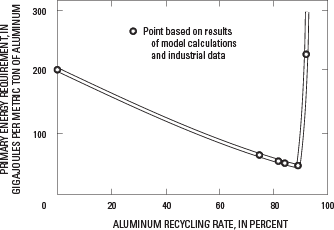
Figure 8. Primary energy requirement for producing aluminum as a function of the recycling rate for aluminum in packaging material (modified from Alkan and others, 1999; courtesy of Encyclopedia of Life Support Systems Publishers, Oxford, United Kingdom).
A potential material for metal recycling can be classified according to whether the metal it contains is concentrated or is dilute and highly disseminated. Recycling of relatively concentrated secondary metals requires less energy than does the smelting of their primary ores or concentrates. Recycled aluminum, for example, requires only 5 percent of the energy needed to produce primary aluminum; for copper, the figure is 20 percent; for lead, 50 percent. Lead in car batteries is an example of a concentrated metal that is easily recyclable. The high concentration of lead in these batteries, combined with their relatively short lifetime, is the reason why lead in car batteries has a recycling rate of more than 50 percent. In contrast, zinc in skin cream and titanium in paint are at the other end of the concentration scale. No one would ever think of trying to recover metals from these products. The more disseminated a metal is in the secondary raw material, the more energy required to purify it.
Substitution of one raw material for another, such as plastics or concrete for metals, occurs constantly in industry and is driven by economics. However, substitution also can be driven by efforts to promote sustainable development. One way to do this is through consideration of a hierarchy of relative mineral resource values like that illustrated in figure 9. The top of the hierarchy is occupied by the most valuable resources (that is, the energy resources represented in fig. 9 by fossil fuels). The next lower value category consists of those mineral resources whose deposits are created by natural enrichment (for example, metalliferous deposits and some nonmetallic deposits like phosphate and barite). The next lower level consists of bulk raw materials such as those used in construction and those whose availability from the geological point of view is unlimited in the Earth’s crust. Also included are materials such as magnesium and potassium, which are present in practically unlimited quantities in the oceans and may be considered essentially as renewable resources. At the base of the hierarchy are the waste products and residues from beneficiation or burning of higher value resources. An example is ash from coal-fired powerplants, which can be used for making cement, thereby replacing primary cement raw materials. Lower value resources should always substitute for higher value ones.

Figure 9. Hierarchy of mineral resources for managing sustainable development (Wellmer and Becker-Platen, 1999; courtesy of Encyclopedia of Life Support Systems Publishers, Oxford, United Kingdom). Resource values increase upward.
Whenever possible, the aim of mineral policy in the sense of sustainable development must be to utilize low-value resources at the base of the mineral resources hierarchy in order to conserve high-value resources at the top. An example of how this may be achieved is through a materials-flow law like Germany’s Waste Avoidance, Recovery and Disposal Act, which penalizes waste disposal. This law promotes maximum utilization of waste products and minimum disposal of waste. Other measures include regional planning that permits unimpeded access to bulk mineral resources, in combination with laws encouraging environmentally compatible mineral extraction. The application of the mineral resources hierarchy to sustainable development is illustrated by the following two examples.
Triple-pane window glass is mandatory in Sweden. When the resulting energy savings for heating a house exceeds the amount of energy required to manufacture the triple-pane glass for the windows, then the energy balance is positive. Thus, raw materials that are lower in the resources hierarchy (sand, limestone, dolomite, and soda ash) replace energy resources at the top (fig. 9).
A new high-speed railway system under construction in Europe is required to follow the most direct routes possible between cities. Consequently, many tunnels and bridges are being built. Tunnels make up 34 percent and bridges make up 12 percent of the northern half of the new railway line between Hannover in northern Germany and Munich in southern Germany (Geissler and others, 1982). Primarily, the new railway system improves traveltime, but it also represents a massive investment in bulk construction materials and steel to improve energy efficiency.
Indicators of efficiency in the utilization of natural resources have been developed in various countries because, as the consideration of the mineral resources hierarchy above illustrates, it is not helpful to consider natural resources as equivalent entities (for example, making 1 metric ton of an energy resource equivalent to 1 metric ton of a metal or 1 metric ton of a bulk material). Rather, it is more helpful to measure the efficiency of utilization of the resources at the top of the hierarchy by measuring the intensity of their use. For the energy resources, the intensity of use is measured by the ratio of a unit of energy consumed to a unit of gross national product, or vice versa. Figure 10 shows how energy efficiency in Germany improved from 1990 to 1996 in the context of the nation’s goal to double energy production by 2020 (Bundesministerium für Umwelt, Naturschutz und Reaktorsicherheit, 1998).

Figure 10. Development of energy efficiency in Germany (modified from Bundesministerium für Umwelt, Naturschutz und Reaktorsicherheit, 1998). Measured in millions of Deutsche Marks (DM) gross national product per petajoule (PJ) consumed.
Learning is a process that normally follows a sigmoidal curve. At the beginning, the learning curve is almost flat; that is, the start is difficult; then the curve steepens, and finally it flattens again when a saturation stage is reached and the rate of learning declines. All of the examples cited above of methods for replacing nonrenewable resources by functionally equivalent resources or achieving higher efficiencies in using mineral resources as required by rule 2 of the Enquete Commission can be shown to follow such a learning curve. On the other hand, experience shows that learning curves may start anew with a technological breakthrough or radical innovation. This circumstance is exemplified by a learning curve based on the efficiency of generating electricity with lignite as fuel in German powerplants (fig. 11).

Figure 11. Increase in the efficiency of generating electricity in German lignite-fired powerplants; information from DEBRIV (Deutscher Braunkohlen-Industrie-Verein e.V.; German Association for the Lignite Industry). MW, megawatt.
Learning is critical for improving the efficiency of production and utilization of our natural resources. In figure 6, it was shown that the bulk of natural resource consumption is occurring in the industrialized nations. This group of countries has gone through a learning curve, becoming more and more efficient in using natural resources. This occurrence is illustrated for copper consumption in figure 12. The growth rate shown in figure 12B generally decreased from the end of World War I to the middle of the 1980s. Since that time, the growth rate for copper consumption has flattened out in the industrialized nations. However, the growth rates in world consumption are increasing again because of high growth rates in takeoff and developing nations like China (Wellmer and Wagner, 2000). The consequence is that we shall see the development of a new learning curve in the countries with high growth rates today.
A 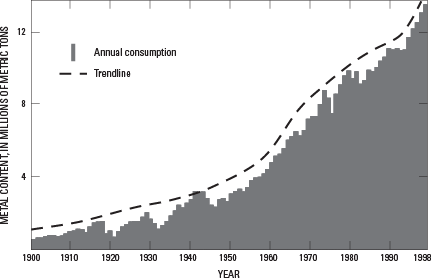
B 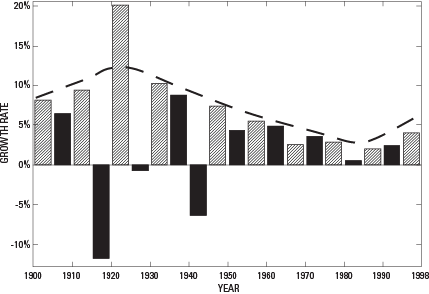
Figure 12. Worldwide copper consumption and growth rates from 1900 to 1998 (Wellmer and Wagner, 2000). A, Annual worldwide copper consumption. B, Growth rates of worldwide copper consumption where 5-year mean values are calculated relative to the previous 5-year period.
It has been argued that takeoff and developing nations take over more efficient technologies immediately and skip less efficient intermediate steps. This certainly is true for selected technologies; for national economies as a whole, however, this development has not been observed so far (for example, steel consumption, as shown in fig.13).
Figure 13A shows the intensity-of-use (IOU) factors for steel for a selected group of developing, takeoff (newly industrialized), and industrialized nations. A bell-shaped curve can be clearly seen in the plot of kilograms of iron consumption per $1,000 gross national product versus gross national product per capita. The intensity-of-use factors rise within the group of developing nations, reach a peak in the group of takeoff nations, and decline toward the group of industrialized nations. This curve results mainly because of the increasing importance of the tertiary service sector but also because of learning effects. If the theory that takeoff and developing nations skip stages in favor of more efficient natural resource utilization were true for entire national economies, a flattening of this bell-shaped curve as shown in figure 13B would be expected. What we observe, however, is the opposite trend. Figure 13C shows the intensity-of-use factors for two time slices—1985 and 1995. It can be clearly seen that the bell-shaped curve has a more pronounced peak in 1995 than in 1985. This difference obviously means that the growth of the developing nations and takeoff nations is based on more rather than fewer natural resources.
The three-cornerstone concept for sustainable development in the 1992 Rio Declaration was extended herein to a four-cornerstone concept by adding research and technology (fig. 7) to improve efficiency in the use of natural resources. Figure 13 illustrates overall the need for increased efforts in this field in order to reverse the trend shown in figure 13C.
A 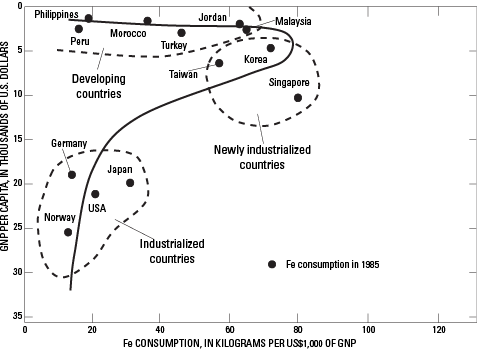
B 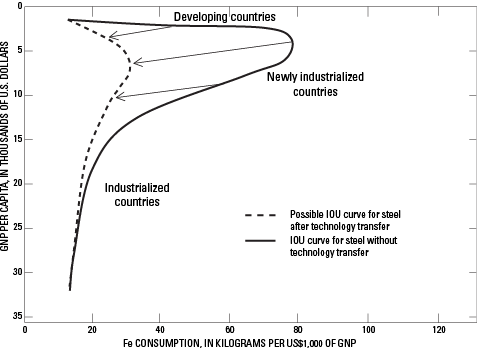
C 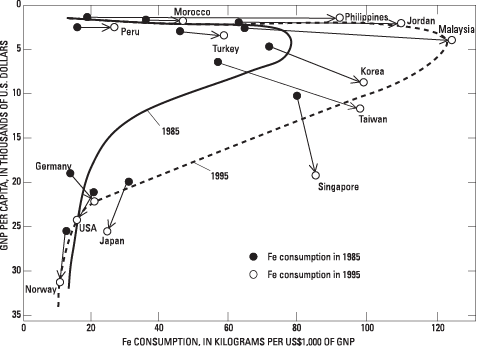
Figure 13. Intensity-of-use (IOU) factors for steel (in 1990 U.S. dollars) for three situations for selected countries (Wellmer and Wagner, 2000). A, IOU factors for steel in 1985. Dashed lines enclose groups of countries as labeled. B, Possible development of IOU curve for steel after successful transfer of technology (dashed line); this hypothetical curve is not observed as shown in figure 13C. C, Comparison of IOU factors for steel in 1985 and 1995. Fe, iron; GNP, gross national product.
To increase the efficiency of entire national economies with respect to the utilization of natural resources, one must take into account that each economic system has to advance through its own stages of learning. In the metallurgical field, industrialized nations have advanced to a relatively efficient stage that optimizes energy input (Wellmer and Becker-Platen, 2001). The present situation in industrialized countries, however, is the result of many learning steps, which proceeded through stages that were inefficient and certainly not sustainable by today’s standards. A good example is the use of charcoal for smelting, which led to excessive cutting of timber and the formulation of the first rule for sustainable development by von Carlowitz (1713).
Developing nations, of course, will not go through these same stages again but, for a variety of reasons, will have to start on a lower part of the learning curve before reaching a high degree of resource efficiency. As an example, many smelters produce not only metals but also residues like slag and sulfuric acid. In industrialized nations today, all residues can be used in most cases in other industrial sectors (for example, slag in the construction industry; sulfuric acid in many chemical processes). The result is that residues at the base of the natural resources hierarchy of figure 9 are used again, thereby replacing primary higher value resources. However, such reuse of residues requires a developed chemical industry, which a developing nation generally does not have when it starts to industrialize by using its own natural resources.
So far we have dealt only with rules 1 and 2 of the Enquete Commission. We also have to consider rules 3 and 4, which address the resilience of the environment.
Per the maxim, “He who mines must dig,” digging is unavoidable, even though it has an environmental impact. In a recent study by Neumann-Mahlkau (1997), it was shown that anthropogenic mass movements have reached the same order of magnitude as geogenic mass movements: about 35 billion cubic meters per annum (m3/a) compared to about 37 billion m3/a. Fortunately, humanity has learned much over the past 30 years about reducing the environmental effects of mining. Good mining practices always use the best available technology that also takes into account inescapable economic considerations. Such practices sometimes are labeled “BATNEEC” that is, best available technology not entailing excessive costs. Implementing BATNEEC means increasing limits on the quantity of water and reagents reaching the environment from the beneficiation of ores and implementing strict regulations about restoring mine sites. It also involves minimizing the land area used for mining. For example, it has been calculated that only about 0.01 percent per year of the land area of Germany is used for exploiting natural resources (Gwosdz and Lorenz, 2000). Moreover, this percentage must have a bias toward higher land usage than in other equivalent industrialized countries because Germany is the world’s largest lignite producer, having very large open pits. Germany also is a significant peat producer, for which relatively large production areas are required, as well. Nonetheless, all land used for mining and quarrying today is used only intermittently in most industrialized nations; such land areas are “borrowed.” In Germany, for example, all such land must be restored for industrial, agricultural, forestry, or recreational purposes or as a nature reserve (re-naturation).
Accidents, especially those involving tailings dam failures, have caused considerable damage to the environment and, in the past, led to widespread public criticism of the mining industry. Although environmental damage should not be played down, it must be pointed out that geotechnical methods are available for proper construction and safe management of tailings dams. It is a matter of good management and mining practices to enforce strict quality control down the chain of command of mining companies. Many companies increasingly are developing and applying rigorous standardized codes of conduct to their operations worldwide. Examples of national and international codes of conduct are those of the (1) Mineral Council of Australia, (2) International Council on Metals and the Environment (ICME), and (3) World Bank Guidelines for Health, Safety and Environment. ICME is based in Ottawa, Canada. Its members are major international metal mining and smelting companies.
Rules 3 and 4 of the Enquete Commission state that the amount and rate of material and energy input into the environment should not exceed the capacity for their absorption with minimum detrimental effects. In the context of these rules, the problem of soils acting as a sink for anthropogenic substances must be examined. We have to realize that man’s activities have considerably increased anthropogenic heavy-metal concentrations in the soil in and around urban and industrial areas. An example from the Berlin area in Germany is shown in figure 14. Another example is the correlation between the increase of lead in human bones and the increased historical use of lead by humans shown in table 3 (Friege and others, 1985).
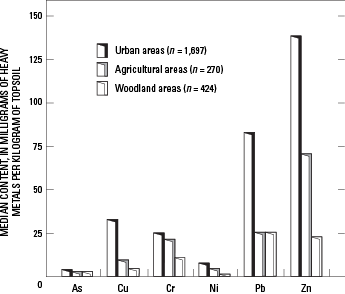
Figure 14. Contents (median values) of selected heavy metals in topsoil in urban Berlin and surrounding rural areas (modified from Birke and Rauch, 1997; courtesy of Encyclopedia of Life Support Systems Publishers, Oxford, United Kingdom). n, number of samples; As, arsenic; Cu, copper; Cr, chromium; Ni, nickel; Pb, lead; Zn, zinc.
| Table 3. Lead content in human bones. [From Friege and others, 1985] |
|||
| Origin of the bones | Date | Lead content1 | Reason for lead content |
|---|---|---|---|
| Inca in Peru | A.D. 500–1000 | 0.55 | No lead used. |
| Teutones in Bavaria | 700–400 B.C. | 2.0 | Early use of lead? |
| Augsburg from late Roman times | A.D. 200–400 | 4.7 | Water pipes, ceramics, lead food containers. |
| Augsburg, rich person from the post-Roman period | A.D. 600 | 4.5 | Luxurious Roman lifestyle. |
| Regensburg, poor person from the post-Roman period | A.D. 600 | 1.4 | No Roman luxury. |
| Regensburg, nuns from the Middle Ages | A.D. 800–900 | 2.4 | Increasing prosperity of the cloister. |
| Regensburg, nuns | A.D. 1100 | 5.1 | Use of lead-bearing tin. |
| Augsburg, monks from the Middle Ages | A.D. 1000–1200 | 5.0 | Printing presses and so on. |
| Modern person | A.D. 1983 | 11–12 | Lead in gasoline and so on. |
| 1Milligrams of lead per kilogram of bone. | |||
Continued and increased efforts must be made to devise improved methods for reducing emissions, thereby protecting our soil so that its capacity to function as a sink for pollutants is not diminished. Significant advances have been made in industrialized countries in the last decade. For example, a recent study by Thomas and others (1999) demonstrated that the phasing out of lead in petrol (gasoline) has led to a considerable reduction of lead concentrations in the environment. In addition, a recent study by the U.S. Geological Survey has shown that lead concentrations in sediments declined as much as 70 percent since the 1970s and 1980s (U.S. Geological Survey, 1998; Callender and Rice, 2000).
The process of continually finding new solutions for the replacement of our nonrenewable resources is governed by the prices of these commodities and, for mineral resources, is affected by the cycle of supply and demand and the effects of learning. In the opinion of the authors, this process so far has worked in our market economy to provide a dynamic balance between resources supply and demand. There is no reason to believe that the process will not continue to function in the future. Concerning the environmental aspects and the sink issue, one can be optimistic that improved technologies will find the necessary solutions.
A more pressing problem for humanity lies in another area—food for an ever-increasing population. Freshwater and soil are needed for growing food. In many arid and semiarid areas today, fossil water is being used. Such water must be considered a nonrenewable resource when its slow recharge is measured against its rapid depletion. Huge quantities of soil, which likewise must be considered a nonrenewable resource, are lost every year to erosion by water and wind, thus reducing the amount of arable land. These growing resource constraints, in combination with an increasing population, are significantly reducing the amount of arable land per capita worldwide (fig. 15). This is an historic paradox, where humanity must be more concerned in the future with the availability of nonrenewable resources than with renewable ones.
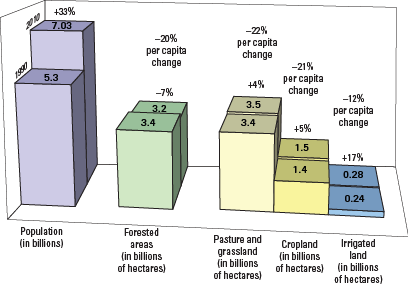
Figure 15. Comparison of population and worldwide land resources in 1990 and 2010 (Wellmer and Becker-Platen, 1999).
Alkan, Z., Briem, S., Dienhart, M., Kugeler, K., and Quinkertz, R., 1999, Methodik und Anwendung eines Energiemodells zur Analyse energetischer Aspekte von Prozessen der Metallherstellung [Methodology and application of an energy model for the analysis of the energy aspects of metal production]: Berichtskolloquium SFB 525, Ressourcenorientierte Gesamtbetrachtung von Stoffströmen metallischer Rohstoffe—Entwicklung von Methoden und ihre Anwendung, RWTH Aachen 20.10.99.
Birke, Manfred, and Rauch, Uwe, 1997, Geochemical investigations in the Berlin Metropolitan Area: Zeitschrift für angewandte Geologie, v. 43, no. 1, p. 58–65.
Bristow, C.M., 1987, Society’s changing requirements for primary raw materials: Industrial Minerals, v. 233, p. 59–65.
Brundtland, G.H., 1987, Our common future—Report of the World Commission on Environment and Development: Oxford, U.K., Oxford University Press, 400 p.
Bundesministerium für Umwelt, Naturschutz und Reaktorsicherheit (German Federal Ministry for the Environment, Nature Conservation and Nuclear Safety), 1998, Nachhaltige Entwicklung in Deutschland—Entwurf eines umweltpolitischen Schwerpunktprogramms [Sustainable development in Germany—Draft environmental program]: Bonn, Bundesministerium für Umwelt, Naturschutz und Reaktorsicherheit, 147 p.
Callender, Edward, and Rice, K.C., 2000, The urban environmental gradient—Anthropogenic influences on the spatial and temporal distributions of lead and zinc in sediments: Environmental Science and Technology, v. 34, no. 2, p. 232–237.
Enquete-Kommission Schutz des Menschen und der Umwelt [Enquete Commission on Protection of Man and the Environment], 1993, Verantwortung für die Zukunft—Wege zum nachhaltigen Umgang mit Stoff- und Materialströmen [Responsibility for the future—Sustainable materials and materials flow]: Bonn, Economica-Verlag, 332 p.
Friege, Henning, Kost, Ulrich, and Claus, Frank, eds., 1985, Die tückische Hypothek—Chemiepolitik für Schwermetalle [The malicious mortgage—Chemistry politics for heavy metals]: Karlsruhe, Verlag C.F. Müller, 219 p.
Geissler, H., Moeker, H., Sauer, G., and Schrewe, F., 1982, Tunnelplanung der Deutschen Bundesbahn in erdfallgefährdetem Gebiet—NBS Hannover-Würzburg, Leinebusch-Tunnel [Tunnel planning in a region of subsidence—New high-speed railway line from Hanover to Wuerzberg, Leinbusch Tunnel]: Rock Mechanics, Supplementum 12, p. 63–73.
Gwosdz, W., and Lorenz, W., 2000, Flächenbedarf für den Abbau von oberflächennahen Rohstoffen (Steine und Erden, Braunkohle und Torf) im Jahr 1997 [Area requirements for the dismantling of raw materials near the surface (stones and ground connection, brown coal and peat) in the year 1997]: Hannover, Federal Institute for Geosciences and Natural Resources, Fakten, Analysen, wirtschaftliche Hintergrundinformationen, v. 9, 4 p.
Jeffery, W.G., 1998, A world of metals—Finding, making and using metals: Ottawa, The International Council on Metals and the Environment, 41 p.
Kippenberger, Christoph, 2001, Materials flow and energy required for the production of selected mineral commodities—Summary and conclusions: Geologisches Jahrbuch, Reihe H, Sonderheft 13, 55 p.
Neumann-Mahlkau, Peter, 1997, Anthropogenic material flow—A geologic factor, in Zhang, Zhonghu, de Mulder, E.F.J., Liu, Tungsheng, and Zhou, Liping, eds., Geoscience and human survival, environment, natural hazards, and global change: Proceedings of the 30th International Geological Congress, Beijing, China, August 4–14, 1996, v. 2–3, p. 61–66.
Taylor, H.K., 1978, Mine valuation and feasibility studies, in Hoskins, J.R., and Green,W.R., eds., Mineral industry costs (2d ed.): Spokane, Wash., Northwest Mining Association, p. 1–17.
Thomas, V.M., Socolow, R.H., Fanelli, J.J,. and Spiro, T.G., 1999, Effects of reducing lead in gasoline—An analysis of the international experience: Environmental Science and Technology, v. 33, no. 22, p. 3942–3948.
United Nations Environment Programme, 1989, Statement of sustainable development: 15th Session of the Governing Council, Governing Council Decision 15/2, May 23, 1989, Annex II, GOAR, 44th Session Supplement, no. 25.
U.S. Geological Survey, 1998, Getting the lead out—Positive effects of the Clean Air Act: U.S. Geological Survey Web page at https://pubs.usgs.gov/msb/7000083/report.pdf.
von Carlowitz, H.C., 1713, Sylvicultura oeconomica: Leipzig, Braun, 432 p.
Wellmer, F.-W., and Becker-Platen, J.D., eds., 1999, Mit der Erde leben—Beiträge Geologischer Dienste zur Daseinsvorsorge und nachhaltigen Entwicklung [Living with the Earth—Contributions of geological services to ensure life and sustainable development]: Berlin, Springer-Verlag, 273 p.
Wellmer, F.-W., and Becker-Platen, J.D., 2001, World natural resources policy—Focussing on mineral resources, in Our fragile world—Challenges and opportunities for sustainable development: Oxford, U.K., Encyclopedia of Life Support Systems Publishers Co. Ltd., v. 1, p. 183–207.
Wellmer, F.-W., and Becker-Platen, J.D., 2002, Sustainable development and the exploitation of mineral and energy resources—A review: International Journal of Earth Sciences, v. 91, no. 5, p. 723–745.
Wellmer, F.-W., and Lorenz, W., 1999, Von den (Edel-) Metallen zu den Nichtmetallen—Bodenschätze im Wandel ihrer volkswirtschaftlichen Bedeutung [From metals and noble metals to nonmetals—Changing economics of our land’s natural resources]: Schriftenreihe der Georg-Agricola-Gesellschaft, Bochum, Georg-Agricola-Gesellschaft, v. 24, p. 97–116.
Wellmer, F.-W., and Wagner, Markus, 2000, Rohstofftrends am Beginn des 3. Jahrtausends [Raw material trends at the beginning of the third millennium]: Erzmetall, v. 53, no. 10, p. 569—582.
Footnote 1. Bundesanstalt für Geowissenschaften und Rohstoffe (BGR) [Federal Institute for Geosciences and Natural Resources] and the Lower Saxony Geological Survey (NLfB), Stilleweg 2, D–30655, Hannover, Germany.